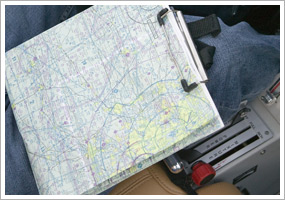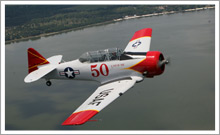| ||||
| | FT News | INSIDE AOPA | TRAINING PRODUCTS | FINAL EXAM | |||
TRAINING TIPs Same route, different plans Terrain is one consideration. A route with prominent landmarks from start to finish begs for the low-tech pilotage approach, letting you focus on holding course and altitude, secure in knowing that you are well established on your route. Flight above more uniform countryside is easier with electronic assistance. Set the destination in your GPS, or intercept and track the VOR radial that will take you there. Make distance checks along your course by identifying radials from other VORs that cross your course line as you proceed along the route. As your experience grows, you can set new challenges for your cross-country flights. Fly a route that requires you to choose between transiting or overflying some busy airspace. Or select the route that would let you fly the entire course while squawking the VFR transponder code 1200 and staying off the radio until your arrival at the destination. Altitude selection is often dependent on a compromise between terrain clearance for the minimum altitude you would fly, and cloud heights for the highest. (You can fly above some clouds, but remember that when flying solo as a student pilot, you must always maintain visual reference to the surface. This would prohibit solo flights in clear air above an overcast.) You can fly at one altitude for the entire route, or take a laddered approach. That method builds in some practice for that future flight when the altitude you choose becomes unusable because of clouds, low visibility, or turbulence. Just as pilots develop certain habits for flying their cross-countries, they get used to individual aircraft in the training fleet. One of these days you might go out to the field for a cross-country flight, only to find that you’ve been switched to that other trainer with a very different set of radios and navigation capabilities. That’s when you’ll be glad you can select among many different plans to get to your destination. YOUR PARTNER IN TRAINING“Any traffic in the pattern, please advise”? “Tally ho”? You will hear phrases on the radio that don’t quite sound legitimate. The Aeronautical Information Manual (AIM) is the best reference for learning good ATC communication skills and phraseology. AOPA's aviation subject report on radio communications can help you too.
Did you know that student pilots who join AOPA are three times more likely to complete their flight training? Membership includes unlimited access to aviation information by phone (800/USA-AOPA, weekdays from 8:30 a.m. to 6 p.m. Eastern time) or from Flight Training Online or AOPA Online. If you're not already a member, join today and get the pilot’s edge. Login information is available online. FLIGHT TRAINING NEWSSIUC takes NIFA championshipThe flight team at Southern Illinois University at Carbondale (SIUC) took home top honors at the National Intercollegiate Flying Association’s championship in May. The Flying Salukis beat out the University of North Dakota by nine points. Rounding out the top five colleges were Embry-Riddle Aeronautical University-Prescott, Western Michigan University, and The Ohio State University, which hosted the event. For a detailed look at what goes on during a NIFA event, read Mike Collins’ feature in the December 2005 Flight Training magazine. Calif. flight school bill moves forwardWith a moratorium that protects California flight schools from costly regulatory burdens set to expire July 1, AOPA and its legislative partners are working to assure a smooth transition to a permanent solution. The California Senate took an important step toward that goal May 23, passing Senate Bill 619, which would exempt flight instructors and flight schools “that provide flight instruction pursuant to Federal Aviation Administration regulations and meet certain criteria” from provisions of the California Private Postsecondary Education Act of 2009. Read more >> Puerto Rico flight school sponsors scholarshipsSilver Wings Aviation Academy in San Juan, Puerto Rico, joined forces with a local business to promote general aviation within the community. Silver Wings and Computer Paradise Inc. offered scholarships to eight high school students. They completed a four-month ground school course and will take the private pilot knowledge test in June. The three students with the highest test scores will receive fully paid private pilot training. Making sense of IFR GPS operationsAre you training for the instrument rating? You’ll soon find that while there’s no doubt that technology can help us become safer pilots, learning that technology can be a daunting task. When it comes to using your GPS for instrument flight, the middle of a cloud is no place to fumble with making sense of the buttons and which ones you need to push. Let the Air Safety Institute put you on the right path to understanding it all with the GPS for IFR Operations online safety course. Girls with Wings brings aviation to Minn. communityGirls with Wings, a nonprofit organization aimed at introducing young girls to aviation, recently held an Aviation Appreciation Day at South St. Paul Municipal-Richard E. Fleming Field in Minnesota. The May 28 event included tours of the Commemorative Air Force museum and a static display, and drew more than 250 attendees. Four sessions of up to 30 girls learned how to become a pilot, and the sessions concluded with introductory flights for the participants. Girls with Wings founder Lynda Meeks said the organization will look for opportunities to sponsor this type of event at other locations. Inside AOPAShould you reset a popped circuit breaker?Seemingly benign electrical malfunctions can blossom into full-blown problems, and you’d better be familiar with your aircraft’s electrical system to prevent that from happening. Talk to your flight instructor and enlist his or her help to get acquainted with the airplane’s manual and interpret the intricate schematics of electrical switches and circuit breakers. Then check out the Air Safety Institute’s Electrical Systems Safety Spotlight to learn more about recognizing and troubleshooting electrical malfunctions. Become a better, more informed pilotWhether it’s simply refreshing one’s skills or learning a potentially life-saving maneuver, becoming a better, more informed pilot is critical to our flying. Attending seminars is one important way to help keep your skills sharp. It’s for that reason that AOPA has developed more than 60 hours of educational seminars, all available under one roof at AOPA Aviation Summit, Sept. 22 through 24 in Hartford, Conn. View the full seminar schedule and register today. Members receive rewards by renting with AvisAOPA members who rent with Avis twice for two consecutive days on each rental before Dec. 31 can receive a complimentary rental reward day. Within two weeks of completing two qualifying rentals, receive a certificate via email to be used on a weekday, weekly, weekend, or monthly rental. Read more >> TRAINING PRODUCTSDavid Clark mic protector from Wick’sIt’s the little things that can make a difference. The microphone “muff” on the David Clark headset isn’t just there for show: It reduces wind and ambient cockpit noise while transmitting. If yours went missing, you can order a replacement from Wick’s Aircraft Supply for $4.25. Order online.
Note: Products listed have not been evaluated by ePilot editors unless otherwise noted. AOPA assumes no responsibility for products or services listed or for claims or actions by manufacturers or vendors. FINAL EXAMQuestion: I’ve been training for my private pilot certificate for a few months now and I’m anticipating that in just a few flight hours my instructor is going to endorse me for my first solo flight. I'm excited about reaching that milestone; however, I’m also a bit nervous. Does AOPA have any information on what someone’s first solo flight is like?
Answer: Congratulations on the progress you have made so far with your flight training. Reaching the solo flight stage is a major accomplishment. Check out the Solo Resources on the Flight Training website, which include frequently asked questions, quizzes, and loads of other information to help you as you approach your first solo. Also, be sure to explore the entire Flight Training website, which includes a wealth of information for student pilots.
Got a question for our technical services staff? Email [email protected] or call the Pilot Information Center, 800/872-2672. Don’t forget the online archive of “Final Exam” questions and answers, searchable by keyword or topic. What’s New OnlineDiverting is more than just an exercise for the private pilot checkride, and that becomes apparent when you’re on a long cross-country trip, AOPA Associate Editor Jill Tallman says in this week’s Flight Training blog. AOPA Career OpportunitiesEver dream of turning your passion for aviation into a career? We’re looking for an application support engineer and applications engineer. To learn more about other AOPA career opportunities, visit AOPA Online. Picture Perfect AVIATION EVENTS & WEATHER To include an event or to search all events in the calendar, visit AOPA Online. For airport details, including FBO fuel prices, see AOPA Airports. Flight Instructor Refresher ClinicsThe next Air Safety Institute Flight Instructor Refresher Clinics are scheduled in Orlando, Fla., Charlotte, N.C., and Columbus, Ohio, June 4 and 5; San Jose, Calif., and Minneapolis, Minn., June 11 and 12; Phoenix, Ariz., and Ashburn, Va., June 25 and 26; and Memphis, Tenn., July 9 and 10. For a complete schedule, see AOPA Online.
Can’t make it in person? Sign up for the CFI Refresher Online. Air Safety Institute Safety SeminarsAir Safety Institute Safety Seminars are scheduled in Oshkosh, Wis., July 27 through 29; and Germantown, Tenn., Wichita, Kan., Fort Worth, Texas, and West Houston, Texas, Sept. 12. Topics vary—for details and a complete schedule, see AOPA Online. | Advertisers Got news? Contact ePilot. Having difficulty using this service? Visit the ePilot Frequently Asked Questions now at AOPA Online or write to [email protected]. |
| Member Tools : Send feedback | ePilot Archive Editorial Team: ePilot Flight Training Editor : Jill W. Tallman | ePilot Editor: Sarah Brown | Contributor: Alton K. Marsh |

 How many ways are there to fly to tomorrow’s cross-country destination? From choosing a navigation method to selecting an altitude or specific aircraft performance parameters, there are multiple methods of managing the mission.
How many ways are there to fly to tomorrow’s cross-country destination? From choosing a navigation method to selecting an altitude or specific aircraft performance parameters, there are multiple methods of managing the mission.


